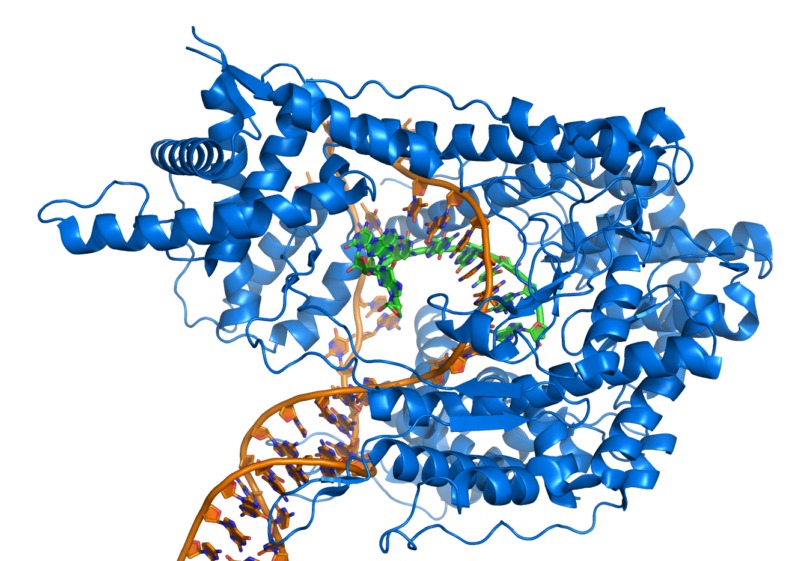“Only a crisis – actual or perceived – produces real change. When that crisis occurs, the actions that are taken depend on the ideas that are lying around. That, I believe, is our basic function: to develop alternatives to existing policies, to keep them alive and available until the politically impossible becomes the politically inevitable.” – When the famous liberal economist Milton Friedman wrote these sentences in “Capitalism and Freedom” in 1962, he was not thinking of medical innovation, and if he was, then only in so far as medicine is related to economics and politics. And as a physician, I do not understand enough of Friedman’s field of expertise to write about what his words mean for the so-called corona crisis in terms of economic policy. But Friedman’s sentences are not meaningless to me, on the contrary: For I see how medical ideas have been “lying around” for years, to be taken up immediately after the first serious cases of pneumonia in Wuhan (China), later called Covid-19, in order to initiate concrete measures.
The development of genetic technical testing procedures had progressed so far that the Berlin Charité was able to provide a test as early as mid-January 2020, just a few days after the publication of the virus’ genetic sequence by Chinese scientists. This test for components of the viral genetic information in the form of RNA (ribonucleic acid) molecules uses a method called real-time polymerase chain reaction (real-time PCR) which can detect a “genetic fingerprint” of pathogens (not the pathogens themselves). In concrete terms, this has made it possible to carry out mass tests which have facilitated the tracing of transmissions from person to person at breathtaking speed. Day after day, growing numbers of infections were detected all over the world, which would not have been noticed at all without this technology.
Resistance is futile
These test results and their central evaluation in turn were the prerequisite for the Covid-19 pandemic being declared by the WHO on 11 March 2020 as well as for many countries, including Germany, for starting to restrict people’s freedom of movement step by step, up to a lockdown with a virtual standstill of public life and the suspension of basic human rights. A few months ago, most people, at least in the West, would probably have thought something like this “impossible”. But due to the overwhelming number of people who tested positive (mostly with mild symptoms or without any symptoms at all), which increased with every news broadcast, the coercive measures became almost “inevitable” and every resistance became futile, because everything followed an inner logic, which is essentially based on recommendations of the WHO.
The lockdown’s purpose was to slow down the spread of the infection, to “flatten the curve”. The policies have two objectives: not to overload the health care system with life-threatening and fatal disease courses, as it had regionally happened in certain countries, and to gain time. – Time for what? This brings us from the testing to a second measure with serious consequences, which also seems inevitable but is still being developed, although progressing rapidly: vaccinations. The consequences can be expected to be serious, because in the foreseeable future, it will most likely no longer be possible to travel or move about as freely globally and even in one’s own country as it was the case before the “corona crisis”, unless one has proof of the vaccination or immunity due to a past infection.
Plug and Play “For A Safer World”
For about five years now, people around the world have been working at full speed on the development of so-called vaccine platforms – another “idea lying around” in Friedman’s terms. Such platforms are new types of vaccines, in which components or genetic sequences of new pathogens can be “plugged” very quickly into an existing matrix (for example a virus or a shell composed of nanoparticles) in order to start vaccination as soon as possible in the event of a pandemic. They are sometimes called “plug and play” vaccines. Coordination of efforts to develop the new vaccines is currently in the hands of CEPI (Coalition for Epidemic Preparedness Innovations), an alliance of private and public investors and foundations (such as the Bill & Melinda Gates Foundation, which contributed $460 million to its creation).
The CEPI, whose motto is “New Vaccines For a Safer World”, was founded in January 2017 at the prestigious World Economic Forum in Davos. This was preceded by initiatives by Bill Gates and the Chancellor of Germany Angela Merkel, for example at the donor conference of the Global Alliance for Vaccines and Immunization (Gavi) on 27 January 2015 in Berlin. Chancellor Merkel, the patron of the conference, met with Bill Gates on this occasion. She presented a six-point plan as early as 2015, which led to the foundation of CEPI, which was supported by the German government with more than €500 million. In the context of the fight against Covid-19, the Federal Ministry of Education and Research of Germany recently added a further €140 million. That’s a lot of money, but on 4 May 2020, an additional €7.4 billion were collected on an international donor conference on the initiative of EU Commission President Ursula von der Leyen, to ensure that Covid-19 vaccines are available within a reasonable period of time. And that’s just the beginning, they say. CEPI, for its part, distributes the money to the vaccine producers and developers, who are to create vaccines, test them in clinical trials and, in a final step, prepare them for mass production.
In a hurry to the finish line
Currently (CEPI communication of 9 April 2020), there are 115 candidates for a vaccine against Covid-19, which are in different stages of development and based on different technologies. Vaccine research and development are mainly in private hands, particularly in companies in the USA, where they are being developed at record speed. In mid-March (16 March 2020), only 63 days after the identification of the gene sequence of the SARS-CoV-2 virus, a clinical study in humans was started and the first vaccine doses were administered immediately. This happened with media attention at the Kaiser Permanente Washington Health Research Institute in Seattle in the northwest of the USA, perhaps not quite by chance the hometown of Bill Gates and the headquarters of the Bill & Melinda Gates Foundation (the Microsoft Corporation is based in the picturesque suburb of Redmond).
As we already reported briefly in the April issue of info3, Moderna, a Massachusetts-based company, has a good chance of winning the race and ultimately becoming one of the three manufacturers who, according to CEPI, will be the first to “cross the finish line”, as its Chief Executive Officer Richard Hatchett, a doctor and former White House official who served in the Homeland Security Council under President George W. Bush and as a member of the National Security Staff under President Barack Obama, put it on faz.net on 10 April 2020. What is meant is that these vaccines will then be used worldwide, whereby three criteria in particular count, which Hatchett called “a kind of mantra”: “Speed, scale, access” (production speed, quantity, and global availability). This sounds military, which is probably intentional, because: “War is an appropriate analogy”, Hatchett said in a television interview published on the website Homeland Security Today on 8 March 2020 about the corona strategy.
Moderna has a chance to be among the winners not only because it started human testing so early, but because it is producing a whole new kind of vaccine that could turn all of medicine upside down. These new vaccines are fundamentally different from conventional methods with live and dead vaccines as we have known them up to now. In a conventional vaccination, biological material, a so-called antigen, is introduced into the body, in which it imitates the infectious agent in such a way that the activation of the immune system induces a defensive response, which results in a permanent immunity against the imitated disease. Such conventional vaccines contain either a purified fragment of the respective pathogen respectively a dead pathogen (“inactivated/killed vaccine”), or an inactivated virus or bacterium (“live, attenuated vaccine”). The vaccines are usually produced by propagating the pathogens in animals, in eggs, or in human cell cultures. Apart from problems of efficacy and tolerability, which can vary greatly depending on the vaccine, conventional vaccines have so far had one main disadvantage: their development often takes many years, which can be far too long in the case of a pandemic with a new pathogen like the new corona virus.
Turning the body into a production site
The novel vaccines, on the other hand, as developed by Moderna and others and promoted by CEPI, are now based on the organism itself producing the actual vaccines. This is done by injecting genes, for example in the form of the gene messenger mRNA (messenger RNA). What happens then has not yet been completely clarified. What is certain is that the synthetic genetic material accumulates in the tissue or in organs, and it is there that the antigens, the actual vaccines, are produced. This is because the injected mRNA contains a “construction manual” for components of pathogens, for example for the so-called spike protein, the “spikes” of the corona viruses, which can currently be seen in many pictures. These antigens stimulate the immune defense, which results in the production of specific antibodies and is critical for the successful vaccination. Subsequently, according to the concept, the cells undergo normal degradation along with the transferred genes. But the vaccination effect should remain the same as with a conventional vaccination.
In contrast to DNA (deoxyribonucleic acid), our mRNA is found in the so-called cytoplasm, the space outside the cell nucleus. There, the mRNA migrates from the cell nucleus, which contains the genetic material in the form of DNA, to the ribosomes, as those cell organelles are called that produce the proteins. Normally, the mRNA mediates between the genetic code and protein synthesis. Vaccinations intervene in these highly complex processes and artificial mRNA causes the cells to produce something that they would not normally produce: typical structures of a pathogen, for example the SARS-CoV-2, as the current coronavirus is called.
It is obvious that work is also being done on the possibility of using this technology to combat other diseases. Modern vaccine research focuses on a diversity of diseases such as cancer, hypertension, substance addictions, obesity, asthma, rheumatism, psoriasis, multiple sclerosis, intestinal inflammation (Crohn’s disease), and many others. This sounds hopeful for many of those affected and for companies alike. Whether such simple and at the same time lucrative solutions will be successful, however, remains to be seen. In most cases, it is completely unclear, how much benefit they will bring to patients. But research is clearly heading in this direction and manufacturers are obviously not afraid to cross such borders. In the future, the human organism could thus, through smuggled-in “Plug and Play” genetic information, become a production site, a factory for a colourful variety of medicines. In simple terms, mRNA vaccines are something like artificial viruses, with the difference that viruses are transmitted through infection while the vaccine RNA is injected or intentionally introduced into the body in other ways. A holistic, Goetheanistic view of cellular processes shows that the function of mRNA is a mediator: between the information pole of the nucleus and the metabolic pole in the cytoplasm. It ensures that in a healthy state, the proteins are always produced on the basis of the hereditary information that the organism needs at any given time.
As a constituent element in the sense of anthroposophical medicine, mRNA and ribosome activity is based above all on the controlling function of the so-called “I organization”, with whose help the organism, on the basis of its inherited characteristics on the one hand, and from environmental conditions on the other hand, emancipates itself by forming an individual protein pattern. The exact effect of interventions in these processes will have to be investigated in the future. After all, it would not be the first time that vaccines or genetically engineered drugs do not have the desired effects, or have not only the desired effects (but unexpected side effects).
As complex as the processes in the cells are, they can also be broken down to a simple reductionist model. If you compare the human organism with a computer, then vaccination is a kind of app. This is how Moderna describes their technology on their website:
Our operating system
Recognizing the broad potential of mRNA science, we set out to create an mRNA technology platform that functions very much like an operating system on a computer. It is designed so that it can plug and play interchangeably with different programs. In our case, the “program” or “app” is our mRNA drug – the unique mRNA sequence that codes for a protein.
Vaccines from the printer
The Tübingen-based company CureVac (see info3 4/2020) also regards mRNA technology as a promising “revolution for life”. It is owned by billionaire and SAP co-founder Dietmar Hopp and the Bill & Melinda Gates Foundation as major shareholders. It is no coincidence that activists from the software industry are now discovering the human organism as the platform for their products. With their disruptive technologies, they consistently implement the successful models of the IT industry and are now applying them directly to humans. CureVac is hoping to revolutionize medicine with, for example, a “vaccine printer” (called “The RNA Printer”), which will enable the production of mRNA vaccine doses in large numbers on site. The code of the mRNA molecule is transferred, without any loss of time through physical transport and without a cold chain, to where the vaccinations are needed, for example in the event of a virus outbreak or for a vaccination against other diseases that are currently occurring in large numbers. “Where others once saw obstacles, we discovered chances”, the motto of CureVac, rooted in transhuman optimism, can be read as a variation of Friedman’s sentence, according to which the impossible becomes inevitable. In times of the corona crisis, many things seem conceivable, even without alternatives, which seemed to be unthinkable or too risky before. ///
Dr. med. Frank Meyer is a family doctor in Germany. He is a regular contributor to Info 3 since 1980 and has authored several books about integrative health and medicine.
From Info 3 Magazine May 2020, Frankfurt am Main, Germany Translated with permission of the editor-in-chief for circulation in the English language.




